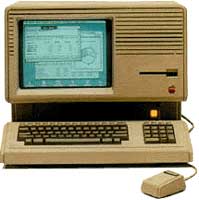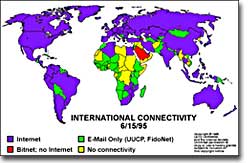Some have begun to call it the Information Revolution. Technological changes brought dramatic new options to Americans living in the 1990s. From the beginning of the decade until the end, new forms of entertainment, commerce, research, work, and communication became commonplace in the United States. The driving force behind much of this change was an innovation popularly known as the Internet.
Personal computers had become widespread by the end of the 1980s. Also available was the ability to connect these computers over local or even national networks. Through a device called a modem, individual users could link their computer to a wealth of information using conventional phone lines. What lay beyond the individual computer was a vast domain of information known as cyberspace.

Upon its release in 1983 the Apple “Lisa” computer — named for one of its developers daughters — was supposed to revolutionize personal computing. But interest in “Lisa” was minimal due to its nearly $10,000 price tag and the introduction of the much more affordable “Macintosh” a year later.
The Internet was developed during the 1970s by the Department of Defense. In the case of an attack, military advisers suggested the advantage of being able to operate one computer from another terminal. In the early days, the Internet was used mainly by scientists to communicate with other scientists. The Internet remained under government control until 1984.
One early problem faced by Internet users was speed. Phone lines could only transmit information at a limited rate. The development of fiber-optic cables allowed for billions of bits of information to be received every minute. Companies like Intel developed faster microprocessors, so personal computers could process the incoming signals at a more rapid rate.
In the early 1990s, the World Wide Web was developed, in large part, for commercial purposes. Corporations created home pages where they could place text and graphics to sell products. Soon airline tickets, hotel reservations, books, and even cars and homes could be purchased online. Colleges and universities posted research data on the Internet, so students could find valuable information without leaving their dormitories. Companies soon discovered that work could be done at home and submitted online, so a whole new class of telecommuters began to earn a living from home offices unshaven and wearing pajamas.
New forms of communication were introduced. Electronic mail, or email, was a convenient way to send a message to associates or friends. Messages could be sent and received at the convenience of the individual. A letter that took several days to arrive could be read in minutes. Internet service providers like America Online and CompuServe set up electronic chat rooms. These were open areas of cyberspace where interested parties could join in a conversation with perfect strangers.

This map shows just how “wired” the world had become as of mid-1995.
Advocates of the Internet cited its many advantages. The commercial possibilities were limitless. Convenience was greatly improved. Chat rooms and email allowed individuals to converse who may never have had the opportunity in the past. Educational opportunities were greatly enhanced because of the wealth of knowledge now placed at the fingertips of any wired individual. “Surfing the ‘net” became a pastime in and of itself.
Critics charged that the Internet created a technological divide that increased the gap between the haves and have-nots. Those who could not afford a computer or a monthly access fee were denied these possibilities. Many decried the impersonal nature of electronic communication compared to a telephone call or a handwritten letter. Hate groups were using the Internet to expand their bases and recruit new members. The unregulated nature of the Internet allowed pornography to be broadcast to millions of homes. Protecting children from these influences, or even from meeting violent predators would prove to be difficult.
Regardless of its drawbacks, by the end of the 1990s, the world was fast becoming wired.

Comments are closed